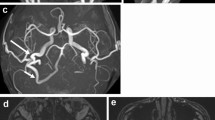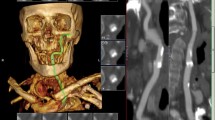Summary.
Background: The majority of previous reports on this rare agenesis of the internal carotid artery (ICA) have been limited to reporting upon its association with other congenital anomalies case by case. In order to collectively summarize this congenital anomaly of ICA, we have reviewed nine cases of ICA aplasia and their associated abnormalities.
Method: Nine cases of ICA aplasia were reviewed. The diagnosis of aplasia or agenesis of the ICA was based on angiographic findings and the presence of an absent or hypoplastic bony carotid canal by temporal bone computed tomography (TBCT). Their presumable embryological aetiologies, initial presenting symptoms, unusual collateral circulations, as demonstrated by angiographies, and various associated anomalies are reviewed.
Findings: The initial presentations were; subarachnoid haemorrhage in three patients, headache in one patient and ischemic symptoms and signs in three patients. The remaining two cases were found incidentally during angiography for other diseases. Collateral circulations to the middle cerebral artery ipsilateral to the ICA aplasia were via posterior communicating artery (P-com) or anterior communicating artery (A-com). On TBCT, all cases but one demonstrated agenesis of the bony carotid canal and the remaining case showed a hypoplastic canal. Cerebral aneurysms were found in six patients, four with A-com aneurysm, one with a basilar bifurcation aneurysm, and one with both a right P-com and a left cavernous ICA aneurysm; two incidentally found cases had no aneurysm. Other associated abnormalities were found in four cases; one case of hypoplasia of the common carotid artery (CCA) with an arachnoid cyst at the temporal pole, one case of abnormal origin of the right CCA from the aorta and the right subclavian artery from the descending aorta, one case of congenital temporomandibular joint (TMJ) ankylosis, and one case of nasopharyngeal angiofibroma with atresia of the upper basilar artery. Except for the atresia of the upper basilar artery, all such abnormalities were found on the same side as the ICA aplasia.
Interpretation: Agenesis or aplasia of ICA may be entirely harmless. However, associated conditions such as cerebral aneurysm or abnormal collateral channels should alert clinicians to the possibility of deterioration to life-threatening conditions, such as subarachnoid haemorrhage or irreversible ischemia. Other associated anomalies are commonly depicted on the same side as the ICA aplasia and may also give rise to issues of clinical importance.
Similar content being viewed by others
Author information
Authors and Affiliations
Additional information
Published online February 10, 2003
Acknowledgment This work is supported in part by a grant from the Seoul National University Hospital Research Fund.
Correspondence: Chang Wan Oh, M.D., Department of Neurosurgery, Seoul National University Hospital, 28 Yongon-dong, Chongno-ku, Seoul, 110-744, South Korea.
Rights and permissions
About this article
Cite this article
Lee, JH., Oh, C., Lee, S. et al. Aplasia of the internal carotid artery. Acta Neurochir (Wien) 145, 117–125 (2003). https://doi.org/10.1007/s00701-002-1046-y
Issue Date:
DOI: https://doi.org/10.1007/s00701-002-1046-y




